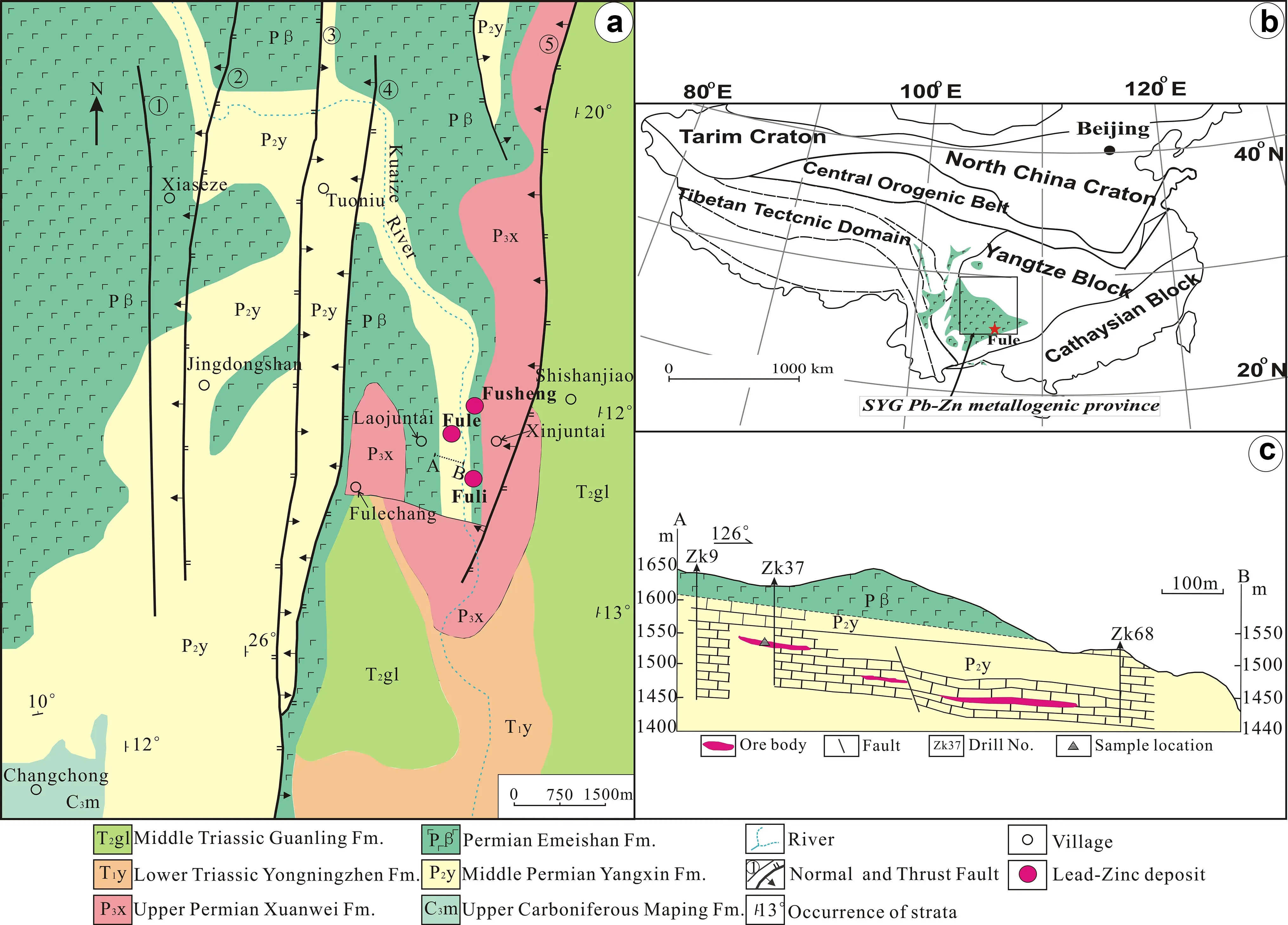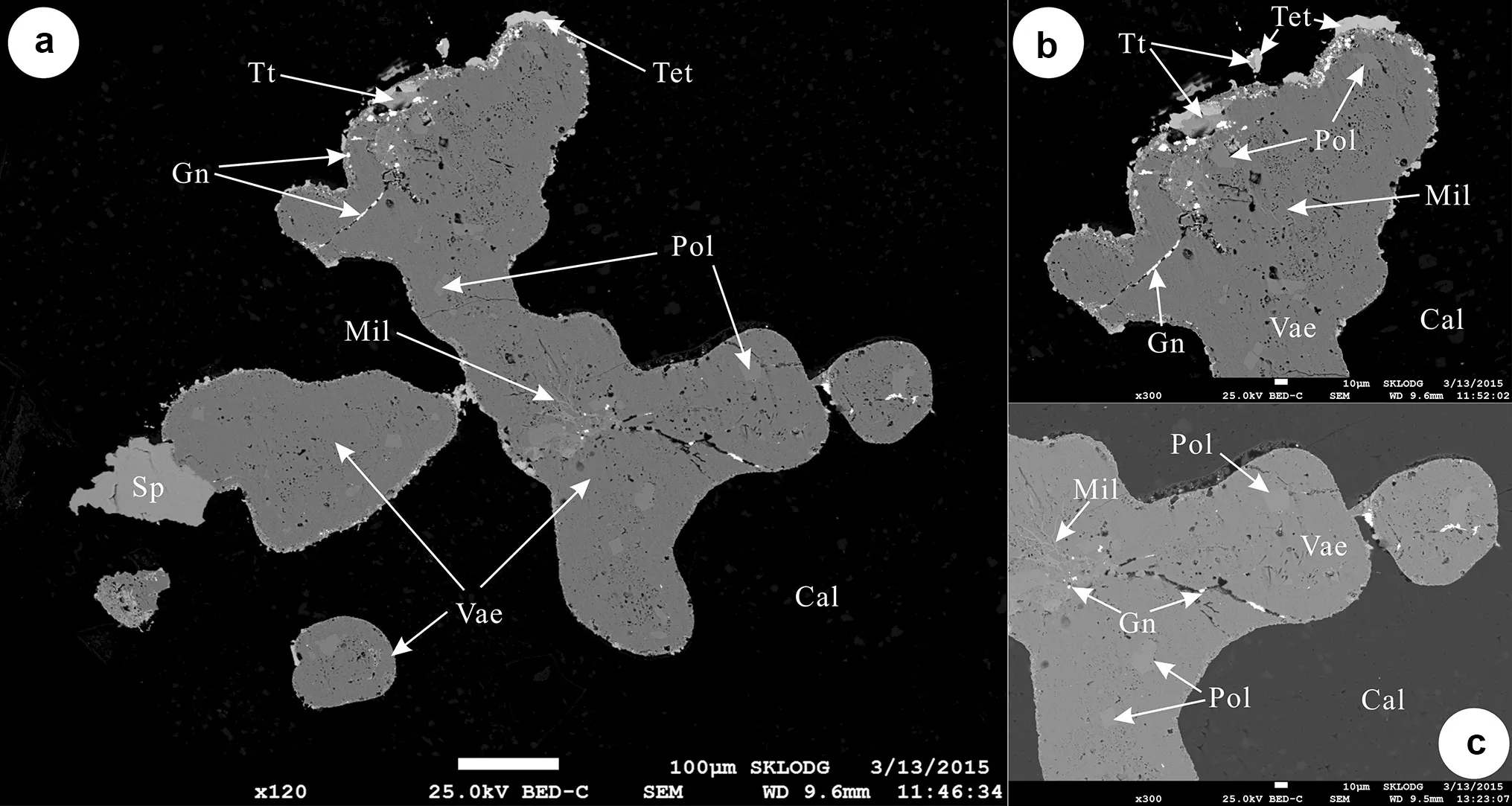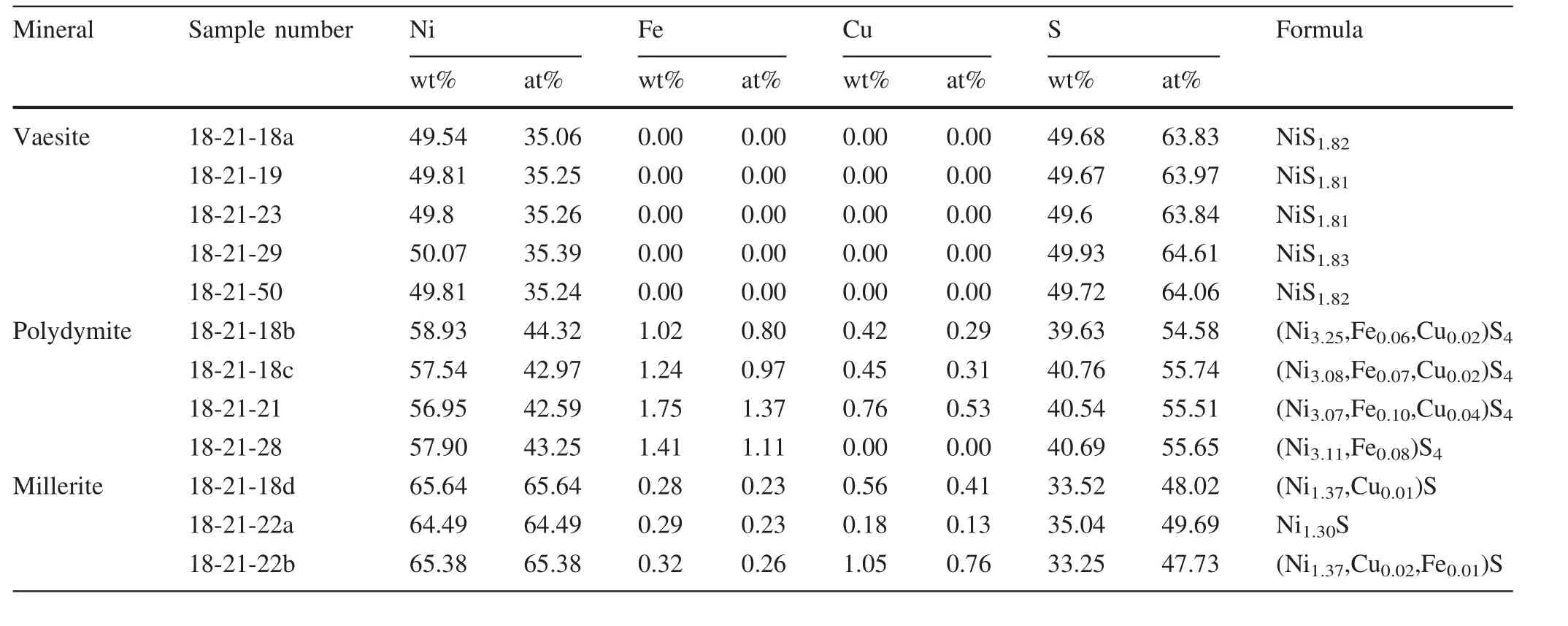Geological significance of nickeliferous minerals in the Fule Pb-Zn deposit,Yunnan Province,China
2018-10-26···
···
Abstract The Fule Pb–Zn deposit is located in the Sichuan–Yunnan–Guizhou Province,and it is an important and giant low temperature metallogenic domain in China.In our research area,the Pb–Zn deposits are mainly hosted in the Permian Yangxin Formation and are composed of dolostone and limestone.The distance between the ore bodies and the Permian Emeishan basalt ranged from 50 to 160 m.In this study,the nickel rich minerals,including vaesite,polydymite and millerite,were reported for the first time in the Fule deposit.These minerals occurred as xenomorphic mineral aggregate and were sporadically distributed in the sphalerite–galena–calcite vein,which is the main ore type in the deposit.Our study indicated that the paragenetic sequence of minerals in the Fule deposit is the following order: polydymite→vaesite→millerite→sphalerite→galena→tetrahedrite(tennantite).The geological occurrence characteristics of those nickeliferous minerals suggested that the Permian Emeishan basalt is a possible barrier layer of Pb–Zn ore-forming fluid,and it is an important source for the Ni and part of the Cu in the deposit.The Sichuan–Yunnan–Guizhou Pb–Zn mineralization province is a world-class production base of Pb and Zn,in which the Permian Emeishan basalt and Pb–Zn deposits have uniformly spatial distribution,but the relationship of mineralization between them is still under debate. This report provides new evidence for understanding the relationship between Pb–Zn mineralization and Permian Emeishan basalt in the Sichuan–Yunnan–Guizhou Pb–Zn mineralization province.
Keywords Nickeliferous⋅Permian Emeishan basalt⋅Fule Pb–Zn deposit⋅MVT deposit⋅Barrier layer
1 Introduction
As the most important part of the giant low temperature metallogenic domain in Southwestern China,the Sichuan–Yunnan–Guizhou Pb–Zn mineralization province(SYGMP)is the important production base of Pb,Zn,Ag and various minor elements(Hu and Zhou 2012;Hu et al.2016;Tu et al.2003;Zhou et al.2013a;Zhang et al.2015).There are over 400 Pb–Zn deposits of different sizes that exist in the 0.17 million km2triangular region,and these are distributed in groups or belts(Liu and Lin 1999).It is undoubted that there is a close spatial relationship between Pb–Zn deposits and Permian Emeishan basalt(Liu 1995;Huang et al.2004),and previous research has shown that they share a similar distribution area and that the vertical distribution of Pb–Zn ore bodies were controlled by the basalt.But whether the Emeishan basalt can provide lead and zinc for mineralization or just serves as a heat source has been debated for decades(e.g.Liu 1995;Liu and Lin 1999;Liu et al.2003;Huang et al.2004;Chen and Liu 2012).The Fule deposit is a representative Pb–Zn deposit in the SYGMP,in which the Pb–Zn ore bodies were hosted in the Permian Yangxin Formation that was composed of dolostone and limestone,which is the most upper stratum hosted with Pb and Zn in this area.The vertical distance between the ore bodies and the Permian Emeishan basalt ranges from 50 to 160 m,and this provides favorable geological conditions for understanding the relationship between Emeishan basalts and lead–zinc mineralization.The Fule deposit is a large-scale Pb–Zn deposit that is characterized by a super-richening of disperse elements,including cadmium and germanium (Si et al.2006,2011,2013;Zhu et al.2017).Extant scholarship on the geological and geochemical properties of the Fule deposit are less substantial,but they include the geological characteristics of the deposit(Li 2014),a comparison of deposit types(Lü2014)and a geochemical study of the ore deposit(Si et al.2006,2011;Liu et al.2016).Recently,we found that a small amount of nickeliferous minerals were hosted in the main ore bodies of the Fule deposit,including vaesite,polydymite and millerite.The nickeliferous minerals were formed in earlier stages than sphalerite and galena.This is the first report that these nickel rich minerals occur in the SYGMP.It is suggested that the Ni likely derived from the Emeishan basalt that overlies the ore bodies in the Fule deposit,and that it was leached out under the continuous interaction between the low-to-moderate temperature ore-forming fluids and basalt.This discovery provides new evidence for understanding the coupling relationship between lead–zinc mineralization and Emeishan basalt in the SYGMP.
2 Geological setting
The Fule Pb–Zn deposit is located in the southeastern part of SYGMP and in the southwest of the Yangtze Block(Fig.1b),and it is controlled by the secondary faults of the Mile-Shizong regional fault.The regional faults are dominated by the NE-and NS-trending faults(Fig.1a).The exposure strata in this region are dominated by the Quaternary(Q),Paleogene(E),Middle Triassic Guanling Formation(T2g),Lower Triassic Feixianguan Formation(T1f),Lower Triassic Yongningzhen Formation(T1y),UpperPermian XuanweiFormation (P2x),Permian Emeishan Formation(P2β),Lower Permian Yangxin Formation(P1y),Lower Permian Liangshan Formation(P1l),Upper Carboniferous Maping Formation(C3m),Middle Carboniferous Weining Formation(C2w),Lower Carboniferous Baizuo Formation(C1b),Lower Carboniferous Datang Formation(C1d),Lower Carboniferous Yanguan Formation(C1y)and Upper Devonian Zaige Formation(D3zg).The basement is the Kunyang Group.The Fule mine area is located in the north of Mile-Shizong regional fault.Affected by the deep regional fault,the structures in the mine area are complicated.The fold and fracture the NE-and NS-trending.The main fold is NE-SW trending Tuoniu anticline,its nucleus is the Lower Permian Yangxin Formation,and its wings are composed of Upper Permian Emeishan basalt and the Xuanwei Formation.The trending of faults in the mine area are NS,NE,EW and NW.The NS-trending reverse faults structurally control the mineralizing ore body,and the NW-trending faults are crosscutting ore bodies in the mine pit area.In general,the substructures of anticline and NS-trending faults mainly control the structures of ore bodies in the Fule mine area.
In the Fule mine area,the ore bodies consist of three ore sections,including Laojuntai,Xinjuntai and Tuoniu.Normally,the Pb–Zn ore bodies are 30–1200 m in length,15–770 m in width and 0.2–6 m in height.The grades of Zn and Pb are 0.53–25.24 wt%and 0.04–18.22 wt%,respectively.The total ore reserves are over 2.7 Mt Zn ore,58.8 Mt Pb ore and 4567 t Cd(Zhu et al.2017).The ore bodies hosted in the Lower Permian Yangxin Formation are bedded and bedded-like(Fig.1c).Ore bodies corresponding with hosted strata and the dip angle range from 8°to 28°.The shapes of the ore bodies are irregular,and the largest extension direction is NW–SE trending,followed by one that is NE-SW trending.The buried depth of ore bodies from NW to SE gradually increases.The Pb–Zn mineralization on the surface within the mine area is extensive,but the continuity is poor.A few of the ore bodies that are near the surface are controlled by the fracture;however,the main ore bodies that occur at deeper depths are thicker and appear in bedded and are intersected by ore veins.The ore minerals are dominated by the sphalerite and galena with minor pyrite and little Cubearing minerals(e.g.chalcopyrite,chalcocite and tetrahedrite).The gangue minerals are mainly composed by calcite and dolomite with minor oxidizing minerals,such as hydrozincite,limonite,malachite,and so on.The ore textures include euhedral,subhedral and anhedral granular textures,and the ore structures are massive,veined,disseminated,brecciated and banded.The wall rock alterations occur predominantly because of dolomitization and calcitization,and dolomitization is the most widespread in Pb–Zn mineralization of this area.
3 Sampling and analytical methods
The samples in this study were collected from the level 1535 m of the Fule deposit,where the mean grade of Pb+Zn is about 25 wt%.The ore types belong to the veined primary minerals,including sphalerite,galena,and calcite.The Ni-bearing minerals occur as spot-like in the calcite vein with sphalerite and galena etc.,suggesting the Ni rich minerals and Pb–Zn minerals formed at the same stage of mineralization.

Fig.1 a The geological map of the Fule lead–zinc deposit(modified from Liu and Lin 1999 and Lü2014).b The location of SYG lead–zinc metallogenic province(modified after Zhu et al.2017).c Cross section of the Fule deposit(Reproduced with permission from Si et al.2013)
Systematic studies of the mineralogy were performed at the State Key Laboratory of Ore Geochemistry,Institute of Geochemistry,Chinese Academy of Sciences(IG-CAS),using a Field Emission Scanning Electron Microscope(JSM-6460lv,JEOL,Japanese)equipped with an Energy Dispersive Spectrometer(EDS)(TEAM Apex XL,EDAX,American)and Back Scatter Electron(BSE)imaging capability.Investigation of the mineragraphy was focused on the sample using a 100–300× objective.The EDS was analyzed with an acceleration voltage of 25 kV and an electron beam current of 10 nA and 1 μm beam diameter.The selected analytical spectral lines and deducted background values were achieved by using instrument programs,and some error spectral peaks were artificially calibrated.All related analytic processes were made using the method of Tu et al.(2003)and were performed at IGCAS,Guiyang.All data in this paper are given in terms of weight percent.
4 Analysis results
Some Ni rich minerals were discovered in this study,predominated by vaesite with minor polydymite and millerite.These minerals appear as spot-like and distributedunevenly in main ore types of the deposit-in the form of veins of sphalerite,galena and calcite.The characteristics of Ni bearing minerals are described as the following.
1. The vaesite exists as anhedral forms in calcite vein,and the edges of vaesites often show in arc-shaped and are normally replaced by sphalerite,tetrahedrite,and tennantite(Fig.2b).The galena fill in the gaps of vaesites in the form of tiny particle(Fig.2b,c).The diameter of vaesites are large(100 × 100 μm to 300 × 600 μm),and its color of reflection is grey with the isotropic nature.The results of Energy Dispersive Spectrometer(EDS)analysis show that the elemental contents of Ni and S are 49.54%–50.07%(average 49.81%,n=5)and 49.60%–49.93%(average 49.72%,n=5),respectively,absent of Fe or other elements.The atomic ratio of Ni:S is range from 1:1.81 to 1:1.83,approximate to 1:2.The calculated formula is NiS1.81–1.82,simplified as NiS2,which is similar to the standard vaesite(NiS2,Ni:47.79%,S:52.21%,Wang et al.1984).Combined with the results of microscope identification,this Ni mineral is identified as vaesite.

Fig.2 The BSE images of nickeliferous minerals in the Fule Pb–Zn deposit Sp-Sphalerite;Gn-Galena;Tet-Tetrahedrite;Tt-Tennantite;Vae-Vaesite;Pol-Polydymite;Mil-Millerite;Cal-Calcite
2. The polydymite presents as cubic or cuboid in vaesite,and its size is relatively uniform between 10 × 10 μm and 30 × 50 μm(Fig.2c).The reflectivity of polydymite is higher than vaesite,showing grey white to light yellow in color with the isotropic nature.The results of EDS analysis showed that its main composition is dominated by Ni and S with minor Fe and trace Cu.The contents of Ni and S in this mineral are 56.95%–58.93% (average 57.83%, n=4) and 39.63%–40.76%(average 40.41%,n=4)respectively.The Fe content varies from 1.02%to 1.75%(average 1.36%,n=4),and the Cu content ranges from detection limit to 0.76(average 0.41%)(Table 1).The calculated formula is (Ni3.07–3.25,Fe0.06–0.10,Cu0.00–0.04)S4,simplified as Ni3S4,which is similar to that of standard polydymite(Ni3S4,Ni:57.86%,S:42.14%,Wang et al.1984).
3. Most of the millerites were filled in the vaesite as dendriform structure(Fig.2b,c).Their reflection color is milky yellow to light yellow with strong isotropy.The mineral is composed by Ni and S(Table 1),and the contents of Ni and S are 64.49%–65.64%(average 65.17%,n=3)and 34.46%–35.51%(average 34.86%,n=3),respectively.The atomic ratio of the minerals is approximate to 1:1.The calculated formula is(Ni1.03–1.37,Cu0.00–0.02,Fe0.00–0.01)S,simplified as NiS,corresponding to the standard millerite(NiS,Ni:64.67%,S:35.33%,Wang et al.1984).
Based on the mineral paragenesis characteristics of these minerals,the simplified paragenetic sequences in the Fule deposit are listed as the following:polydymite→vaesite→millerite→sphalerite(chalcopyrite)→galena→tetrahedrite(tennantite).
5 Discussion
The Sichuan–Yunnan–Guizhou mineralization province is one of the important productive areas of Pb–Zn-Ag and dispersed elements in China.In recent years,many researchers have shown that all the Pb–Zn deposits(mineralized occurrences)are distributed in groups and hosted from the Permian to Sinian strata in SYGMP,and are mainly presented in carbonate of Sinian and Carboniferous strata.These deposits have obvious epigenetic features,showing the similar characteristics in geology and geochemistry,such as the mineralization types,hosted rocks,paragenesis minerals and wall rock alterations,and all of these characteristics are essentially the same as the typical Mississippi Valley-type deposit(MVT)(e.g.Leach et al.2005).The genesis type of these Pb–Zn deposits developed from the original‘‘reformed and superimposed sedimentary deposit’’to ‘‘MVT type deposit’’(e.g.Huang et al.2004;Han et al.2007;Zhang 2008;Jin 2008;Zhou et al.2013a;Wu 2013;Zhang et al.2015).It is necessary to point out that the morphology of ore bodies in some deposits are significantly different from the typical MVT type deposit,and especially,the ore grades are obviously higher than the MVT type.One of the most typical deposits is the Huize Deposit,Yunnan Province,China,as its Pb–Zn ore bodies occur as super-thick veins with the grades of Pb+Zn>30 wt%,which is one of the highest grade Pb–Zn deposits(e.g.Han et al.2007).This implies that the Pb–Zn deposits in SYGMP belong to the category of MVT type deposit,but have some certain specificities.

Table 1 The EDS analysis results of nickeliferous minerals in the Fule deposit,China(%)
As mentioned before,there are a close spatial relationship between the Emeishan basalt and Pb–Zn deposit in the SYGMP,but the genetic relationship is still under debate.The Fule Pb–Zn deposit was hosted in the Permian Yangxin Formation which is the most upper stratum that contained with the lead and zinc in the SYGMP,and the nearest distance from its ore bodies to Permian Emeishan basalt(the minimum distance is about 50 m)than other deposits.It provides favorable geological conditions for understanding the relationship between Emeishan basalts and lead–zinc mineralization.The Ni minerals(e.g.polydymite)were founded in the deposit at the first time in this study,and it is rarely seen in MVT type deposit(Paradis et al.2007),except in a few MVT deposits,such as the Pine Point,Tri-State and Upper Mississippi Valley Pb–Zn deposits(Leach et al.2005).Due to the lack of related data and figures,it is difficult to compare them.Observed under the microscope,our study shows that the Ni minerals formed earlier than sphalerite and galena.The limited distribution of Ni minerals indicates that the Ni content in the ore-forming fluid was low and that enrichment only partially occurred.In fact,the Pb–Zn ore bodies of the Fule deposit were close to the overlying Emeishan basalt(<160 m,Fig.1c).Therefore,this implies that the Permian Emeishan basalt is a possible barrier layer of Pb–Zn ore-forming fluid,and it is an important source of the Ni and part of Cu in the deposit,which leached out the Ni and Cu(e.g.chalcopyrite,chalcocite and tetrahedrite)from the basalt when the fluid moved nearby the basalt,and that the Ni and Cu bearing minerals precipitated with Pb–Zn mineralization.This conclusion is also supported by the following geological and geochemical evidence:
1. The metallogenic ages of Pb–Zn deposits in the SYGMP were about 200 Ma,such as the Maozu deposit(196 Ma,Zhou et al.2013b),the Jinshachang deposit(202.8–199.5 Ma,Mao et al.2012),the Lehong deposit(200.9 Ma,Mao et al.2012),the Huize deposit(226-225 Ma,Huang et al.2004;Li et al.2007),the Daliangzi deposit(204.4 Ma,Wu 2013),the Chipu deposit(165.7 Ma,Wu 2013)and the Tianqiao deposit(191.9 Ma,Zhou et al.2013c).It is later than the age of Emeishan basalt(±260 Ma,Zhou et al.2002;Sun et al.2010),indicating there is no direct relationship between the magmatic activities of the Emeishan basalt and the Pb–Zn mineralization in SYGMP.
2. Earlier studies have shown that the sulfur of the oreforming fluid was derived from the reduction of marine sulfate in SYGMP,mainly provided by the gypsumsalt bed in hosted strata(e.g.Liu and Lin 1999;Huang et al.2004;Li et al.2006,2007;Jin 2008;Zhang 2008;Zhou et al.2010,2013a,2014).However,the sources of Pb and Zn in this area have been debated.Although some scholars believed that the carbonate strata and basalt are the main source layer(Zhen 1994 and Liu and Lin 1999),recent studies showed that the rocks of Precambrian folded basement(Kunyang Group and Huili Group)were the main sources of Pb–Zn mineralization and that the Emeishan basalt cannot provide a large number of Pb and Zn or other ore-forming materials(Liu et al.2003;Li et al.2007;Jin 2008;Chen and Liu 2012; Zhou et al.2010,2013a,2013b,2013c).The homogenization temperature of fluid inclusions in sphalerite are mainly concentrated in 180–210 °C and 120–160 °C,and the salinity mainly focused in 9 wt%–10 wt%NaCleq and 4 wt%–7 wt%NaCleq,indicating the ore-forming fluid is a medium–low temperature and salinity.Even though the abundances of Pb–Zn in the Emeishan basalt are high(Liu and Lin 1999),the abundant Pb–Zn materials were hardly leached out from the Emeishan basalt at medium–low temperature by the ore-forming fluid.Furthermore,the Emeishan basalt in the mine area has not incurred large-scale alteration,suggesting the Pb–Zn and other materials possibly derived from the basement(Kunyang group).In contrast,the Pb–Zn ore-forming fluid belonged to a medium temperature during the early stage of mineralization,when the fluid migrated to the Emeishan basalt with water–rock interaction.As a result,a few Cu and Ni could be leached out from the basalt and enriched in partially,and favored sulfide mineralization.In the Fule deposit,the nickeliferous minerals(polydymite,vaesite and millerite)occurred with the sphalerite and galena in the same ore vein,whereas the Ni rich minerals were very rare,unevenly distributed,and formed earlier than sphalerite and galena,which was interpreted as the products of the above process.Although it is not possible to completely exclude the possibility that Ni was derived from the basement(Kunyang group),it is clear that the possibility that Ni migrated for a long-distance at medium–low temperature conditions is almost impossible.
3. The Pb–Zn deposits are consistent with the distributed of the Emeishan basalt in the SYGMP.Except for the sand–lead–zinc deposits hosted in the loose layer of the Quaternary basalt,almost all the other Pb–Zn deposits(mineralization spots)were placed under the Emeishan basalt(Liu 1995),implying the spatial control of Emeishan basalts on Pb–Zn mineralization in this area.It is suggested that the Permian Emeishan basalt is a possible barrier layer of Pb–Zn ore-forming fluid,and it is an important source of the Ni and part of Cu in the deposit.
6 Conclusions
1. The nickeliferous minerals,including polydymite,vaesite and millerite,were reported for the first time in Fule Deposit.The Ni minerals occurred as spot-like in calcite vein with sphalerite and galena and formed earlier than other sulfides(sphalerite and galena).It is suggested that the Ni minerals and Pb–Zn minerals formed at the same mineralization stage.
2. The Permian Emeishan basalt is a possible barrier layer of Pb–Zn ore-forming fluid.The Ni and Cu in the basalt were leached out by the ore-forming fluid when the fluid moved nearby the basalt,whereas the Pb–Zn were derived from the basement rocks.It is suggested that the source of ore-forming fluid of Ni,Cu and Pb,Zn are different.
AcknowledgementsThis research project was jointly supported by the National‘973 Project’(No.2014CB440900),the State Key Program of National Natural Science Foundation of China(No.41430315),and the National Natural Science Foundation of China(Grant No.41173063).We would like to thank Dr.Shaohua Dong(SEM Lab.)for her assistance in SEM analysis.
杂志排行
Acta Geochimica的其它文章
- Trace element composition of magnetite from the Xinqiao Fe-S(-Cu-Au)deposit,Tongling,Eastern China:constraints on fluid evolution and ore genesis
- Theoretical calculation of equilibrium Mg isotope fractionation between silicate melt and its vapor
- Zinc isotope fractionation under vaporization processes and in aqueous solutions
- The partitioning patterns of nutrients between pods and seeds of Zanthoxylum fruits impacted by environmental factors
- Iron isotopic analyses of geological reference materials on MCICP-MS with instrumental mass bias corrected by three independent methods
- Effects of a proline solution cover on the geochemical and mineralogical characteristics of high-sulfur coal gangue
